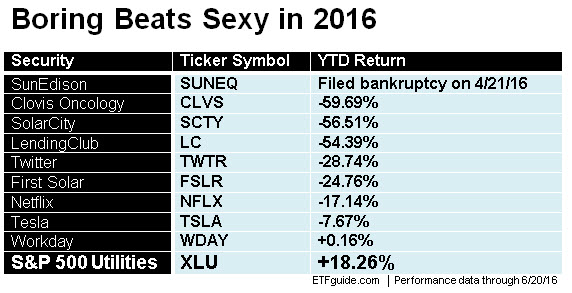Higher investment risk leads to higher investment returns, right? It’s a Wall Street axiom that we’ve heard so many times it’s become ingrained in us. But conventional wisdom and reality have the peculiar habit of departing from one another. And what’s happening in 2016 is a noteworthy example of this grand departure.
With the year already half over, sexy stocks of the day like Netflix (NasdaqGS:NFLX), Tesla (NasdaqGS:TSLA), and Workday (NYSE:WDAY) are all underperforming relative to the broader U.S. stock market (NYSEARCA:VTI). In most cases, this underperformance is substantial. But wait, there’s more.
(Audio) A $3 Million Portfolio Report Card for a Doctor in Vermont
While the total U.S. stock market has eked out a modest gain of +3.3%, the collective performance of sexy stocks has been anything but sexy. Among the group, SunEdison (SUNEQ) filed for bankruptcy protection on April 21, leaving its shareholders holding the proverbial bag. Other companies like Clovis Oncology (NasdaqGS:CLVS), LendingClub (NYSE:LC), and SolarCity (NasdaqGS:SCTY) have lost more than 50% in value.
Meanwhile, the humdrum utilities sector is destroying the performance of group sexy.
Look at the Utilities Select Sector SPDR ETF (NYSEARCA:XLU) which has jumped more than 18% this year and continues to defy detractors.
Utilities are companies that produce and transmit electric power and natural gas. It’s a dull industry sector that has sometimes been called “widow and orphan stocks” because of its conservative nature compared to other stock market industry groups.
Over the past few years, Silicon Valley-types have proclaimed death to utilities due to the rising usage of alternative energy sources like solar power. However, solar stocks (NYSEARCA:TAN) have struggled this year because of questions about the sustainability of their business models along with SunEdison’s fantastic implosion. SunEdison was the epitome of “sexy” because of big-named hedge fund managers that owned it along with its close ties to Wall Street’s underwriters who fueled the company’s addiction to debt.
If there’s one lesson to remember, it’s that sexy may look more appealing, but the sub-optimal results are haunting.
On Jan. 7, 2016 ETFguide PREMIUM initiated a trade in XLU at $43.12. Declining bond yields and the yield for 10-year U.S. Treasury (ChicagoOptions:^TNX) has lifted the utilities group, making it the best performing S&P 500 industry sector thus far in 2016. In other words, boring is beating sexy!
XLU owns a basket of 29 utility stocks like Duke Energy, Dominion Resources, and Southern Co. The fund also carries a 12-month dividend yield of 3.27% further enhancing its performance sizzle for one happy total return. The annual expense ratio for XLU is 0.14% and the fund distributes a quarterly dividend.
Feel free to add to my short list of sexy stocks with un-sexy performance. Who did I miss?




